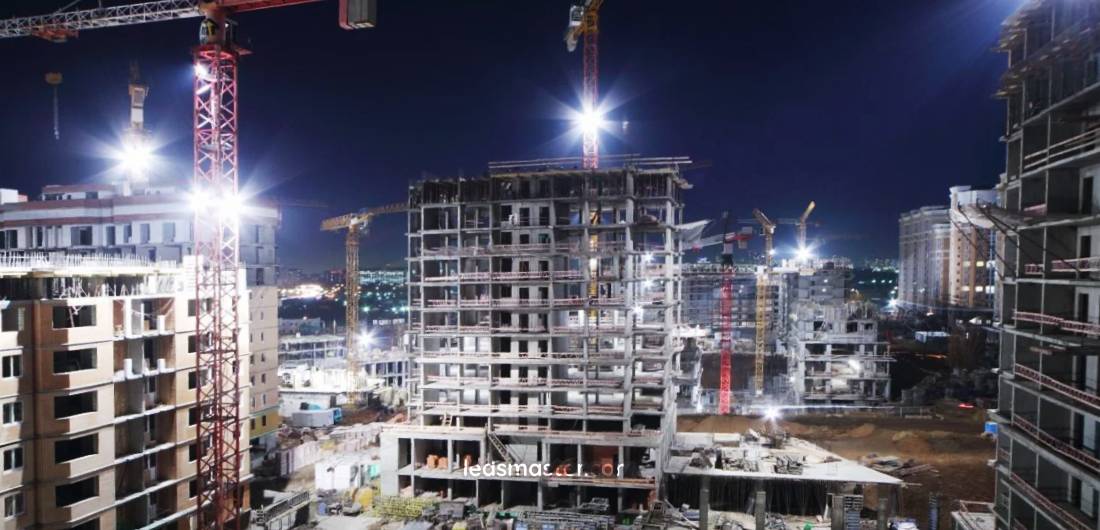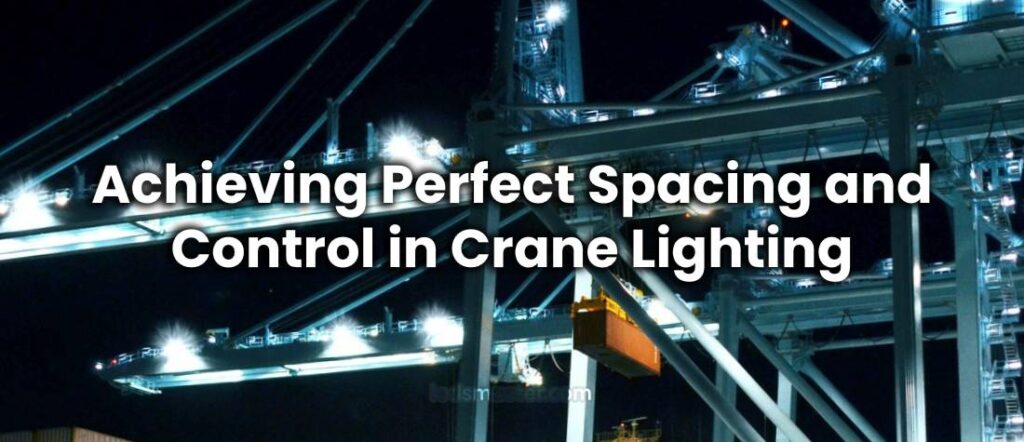Cranes are large, complex machines found in industries such as construction, shipping, manufacturing, and material handling. The need for proper lighting on cranes is paramount, as these machines often operate in low-visibility areas or during nighttime shifts. Proper lighting on cranes enhances worker safety, facilitates more precise operations, and ensures that tasks are carried out efficiently.
However, crane lighting installation is not a simple task, given the complexity of the environment, the dynamic nature of crane movement, and the variety of tasks they are used for. Multiple factors must be taken into account when determining the ideal configuration for lighting, such as the type of crane, the tasks it performs, the work environment, and, importantly, how the lights interact with the crane’s movement.
Table of Contents
ToggleThe Importance of Lighting on Cranes

Crane lighting serves several purposes, from improving the visibility of the load and surrounding environment to helping operators see obstacles or hazards in their path. It is necessary in areas such as ports, construction sites, factories, and warehouses, where cranes operate in dimly lit spaces or during night shifts. In these environments, adequate lighting not only supports worker safety but also helps with the precision of crane operations, particularly when heavy lifting is involved.
Cranes are typically used for lifting and transporting heavy loads. These tasks require a clear view of the crane’s surroundings and the objects being moved, which makes proper lighting crucial. The configuration of lights on a crane impacts the visibility of the load, the operator’s visibility in the cabin, and the illumination of the surrounding area. Moreover, lighting can improve the crane’s operational performance by making the work area more visible, thereby reducing the risk of accidents or mistakes.
Addressing the Challenges of Lighting Installation
One of the most significant challenges in crane lighting installation is designing a system that provides even and consistent illumination while also accounting for the unique aspects of crane operation. Cranes are often located in large, open spaces, and their height and movement require specific lighting setups to ensure that no area remains underlit or overexposed. The lights must be positioned to minimize glare while maximizing visibility across the work area. A poorly designed lighting system can lead to blind spots, inefficient workflows, or potential safety hazards.
Spacing Between Lights in Crane Installations

Spacing between lights is a key consideration in crane lighting installation. To achieve the best illumination while avoiding issues such as glare or shadowing, proper spacing and placement of lights are required. The goal is to ensure uniform lighting coverage over the entire work area while addressing the specific tasks being carried out on the crane. Incorrect light spacing can result in poorly lit areas, causing visibility issues for the crane operator and workers around the crane.
Size and Design of the Crane
The size of the crane significantly influences the spacing between lights. Larger cranes with an extended reach require high-power lighting systems capable of illuminating broader areas. For cranes with booms exceeding 50 feet (15 meters), lights should be spaced approximately 10 to 15 feet (3 to 4.5 meters) apart to maintain consistent illumination without dark spots. Conversely, for smaller cranes with booms under 25 feet (7.5 meters), lights should be spaced closer, typically 5 to 8 feet (1.5 to 2.5 meters) apart, to ensure proper lighting coverage.
The design of the crane also affects light placement. For example, mobile cranes require flexible lighting configurations due to constant movement, with lights positioned at strategic points every 12 to 18 feet (3.5 to 5.5 meters) along the boom. In contrast, overhead cranes, commonly used in warehouses and factories, demand precise light placement near critical areas such as the hoisting mechanism, load area, and operator’s platform, ensuring visibility where it is needed most.
Type of Work Performed
The nature of the work dictates how lights should be spaced. Precision tasks, such as handling fragile materials or assembling components, require lights placed 4 to 6 feet (1.2 to 1.8 meters) apart for accurate illumination over the workspace. For heavy lifting applications, such as moving bulk materials or large construction equipment, the lighting can be spaced farther apart—typically 15 to 20 feet (4.5 to 6 meters)—to cover broader areas efficiently without over-concentration.
Environmental Factors
Operating conditions also impact light placement and spacing. Outdoor cranes working in environments with fog, rain, or dust require high-intensity lighting that can be spaced 12 to 20 feet (3.5 to 6 meters) apart, depending on the level of ambient light interference. In contrast, cranes operating in controlled indoor settings, such as factories or warehouses, need lights placed 6 to 10 feet (1.8 to 3 meters) apart to ensure even lighting and minimize glare or shadows.
Lighting Control on Moving Platforms
Another important consideration for crane lighting installations is the control system, especially on cranes with moving platforms. Lighting systems on moving cranes must be adaptable to the crane’s constant motion to maintain optimal illumination at all times. As the crane moves, the lighting must adjust to ensure that the correct areas remain illuminated, and that the light does not cause unnecessary glare for the operator or other workers nearby.
Types of Lighting Control Systems
There are several ways to control the lighting on a moving crane platform. These systems allow operators to adjust the lights based on the crane’s movement and the specific tasks being performed. The control systems can be manual or automated, depending on the needs of the crane and the work environment.
Automated Lighting Control
Automated lighting control systems use sensors and technology to adjust the lighting based on the crane’s position or movement. For example, automated systems can track the crane’s movements and adjust the lights to ensure that the work area remains fully illuminated. If the crane is lifting or moving loads in a particular direction, the lights can shift to follow the action and ensure optimal visibility. Automated systems can also adjust the intensity of the lights based on the surrounding environment, ensuring that the lighting is appropriate for both the work being done and the conditions around the crane.
Automated systems provide a more sophisticated solution to lighting control, as they respond in real time to changes in the crane’s movement. These systems are particularly useful in large, complex crane operations, where lighting needs may change frequently throughout the workday.
Manual Lighting Control
Manual lighting control is another option for cranes with moving platforms. In this setup, the operator can adjust the lighting using switches or controls located inside the crane’s cabin or platform. This type of system is often used when precise control over the lighting is required. The operator can adjust the light intensity or direct the lights towards specific areas, depending on the task at hand.
Manual control systems are useful in situations where the crane operates in unpredictable or changing conditions. For example, if the crane is moving through areas with varying levels of ambient light, the operator may need to adjust the lights based on visibility. In situations where more focused lighting is needed, the operator can manually direct the lights to the appropriate location.
Wireless Control Systems
Wireless control systems offer a more flexible way to manage lighting on moving cranes. These systems allow operators to control the lighting remotely, which is especially useful for large cranes or those operating in expansive environments. Wireless control systems can be operated from a central location, such as a control room, or directly by the crane operator using a handheld device. Wireless systems are also useful in situations where the crane operator may not have direct access to the lighting controls, such as in high-altitude operations or when operating a crane from a distance.
Wireless lighting control systems can be particularly beneficial in industrial settings where cranes move frequently between different work zones. Wireless controls allow for easy adjustments to lighting in real time, improving the flexibility and efficiency of crane operations.

Ensuring Safety with Lighting Control Systems
Safety is another key factor in the design and control of crane lighting systems. The lighting control system should include safety features that help prevent accidents and malfunctions. For example, fail-safe mechanisms can be implemented to ensure that the lights remain on when the crane is in operation or when visibility drops below a certain level.
Furthermore, lighting systems can be integrated with the crane’s overall safety mechanisms. For instance, the lights can be programmed to automatically adjust based on the crane’s movements or proximity to obstacles. This ensures that the operator has clear visibility of any potential hazards in their path, reducing the risk of accidents.
Lighting systems can also include emergency backup power systems to ensure that the lights remain operational in the event of a power failure or malfunction. This ensures that even if there is a temporary loss of power, workers are still able to operate the crane safely.
Practical Considerations for Crane Lighting Installation
In addition to the technical aspects of crane lighting installation, several practical considerations must be addressed. These include the environmental conditions, safety during installation, ease of maintenance, and future upgrades. Cranes often operate in harsh weather, so lighting components need to be weather-resistant to withstand exposure to elements like rain, snow, and extreme temperatures. The installation process must also ensure that lights are securely mounted, and wiring is protected from damage due to crane movement, avoiding interference with the crane’s operations.
Safety is critical during installation. Installers must follow proper protocols to prevent accidents, often requiring scaffolding, lifts, or cranes designed for maintenance tasks. Accessibility is another key factor: lights must be installed in accessible locations for future maintenance, and systems should be designed for easy repairs, including the quick replacement of bulbs or components.
Additionally, crane lighting systems should be flexible enough for future upgrades to accommodate new technologies. Lighting systems in hazardous environments must meet safety standards to ensure safe operation. The installation process must be efficient, minimizing downtime and coordinating with ongoing crane activity. Finally, the cost and resources required for installation must be considered to balance quality with budget constraints.
Overall, practical considerations like safety, accessibility, and long-term functionality are essential for the successful installation of crane lighting systems. Addressing these aspects ensures that the system operates efficiently and safely in the long term.
Installation Challenges
Installing lighting systems on cranes can be a challenging task due to the height and complexity of the crane’s structure. Technicians must carefully position the lights to ensure they are securely mounted while also providing optimal illumination. The installation process must be completed in a way that does not interfere with other crane operations, such as the hoisting mechanism, operator’s cabin, or control systems. Moreover, the lighting system must be durable and weather-resistant to withstand the harsh conditions cranes often operate in.
The installation process also requires attention to the wiring and electrical components of the lighting system. Wires must be carefully routed to prevent interference with crane movement or other machinery. Additionally, electrical components should be shielded from weather elements, ensuring that they remain functional and safe to operate in various environments.
Ongoing Maintenance and Inspection
Once the lighting system is installed, ongoing maintenance is necessary to ensure its continued functionality. Regular inspections should be conducted to identify potential issues, such as burned-out lights, malfunctioning sensors, or damaged wiring. Components should be replaced or repaired as needed to ensure the lighting system remains effective.
Additionally, regular cleaning and maintenance of the lights are essential to prevent buildup from dust, dirt, or environmental factors. Keeping the lights clean ensures that they continue to provide optimal illumination and maintain their effectiveness over time.
Conclusion
The installation of lighting systems on industrial cranes requires careful planning and consideration of various factors, including light spacing, crane movement, lighting control systems, and the specific needs of the crane’s operating environment. Proper lighting installation ensures safe and efficient crane operations, improves visibility, and reduces the risk of accidents. By addressing these challenges and implementing effective lighting control solutions, crane operators can work more effectively and safely in even the most challenging environments.

